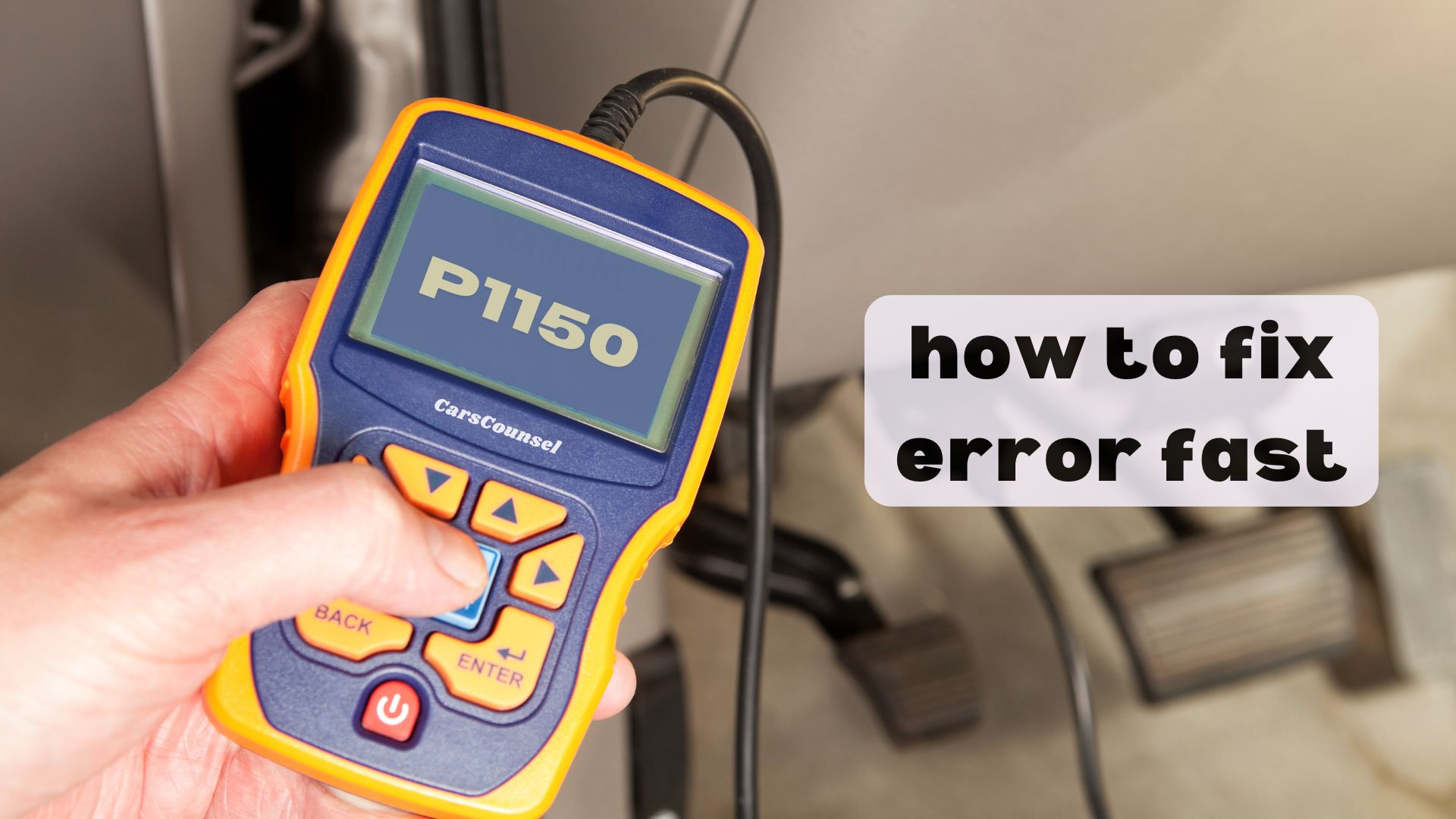Did you know that a faulty air/fuel ratio sensor is one of the most common causes of engine performance issues, affecting over 10% of vehicles on the road?
If your car’s onboard computer has thrown a P1150 code, it’s likely that your Bank 2 Sensor 1 is malfunctioning, leading to decreased engine performance and fuel inefficiency. But what exactly is causing this problem, and how can you fix it to get your car running smoothly again?

Quick Navigation
Key Takeaways
- The P1150 code indicates a malfunction in the Air/Fuel Ratio Sensor Circuit for Bank 2 Sensor 1, affecting engine performance and fuel efficiency.
- Faulty air/fuel ratio sensors, wiring issues, vacuum leaks, and exhaust system leaks can trigger the P1150 code, requiring prompt diagnosis and repair.
- Ignoring the P1150 code can lead to increased emissions, decreased fuel efficiency, and poor engine performance, causing frustration and environmental harm.
- Replacing the faulty air/fuel ratio sensor, repairing wiring or exhaust system issues, and clearing the code can resolve the problem and restore peak engine performance.
- Fixing the P1150 code can help prevent engine damage, maintain fuel efficiency, and reduce environmental impact, making it crucial to address the issue promptly.
Code Description and Causes
Most vehicles have an Air/Fuel Ratio Sensor Circuit that monitors the oxygen levels in the exhaust gases and provides feedback to the engine control module (ECM) to adjust the air-fuel mixture for ideal combustion.
If this sensor fails, it can lead to sensor failure, resulting in fuel inefficiency and decreased engine performance. A faulty air/fuel ratio sensor can cause the P1150 code, which may also be triggered by wiring or connector issues, vacuum leaks, and exhaust system leaks.
You’ll need to identify the root cause to fix the problem and prevent further damage to your engine.
Symptoms of P1150
When your vehicle’s onboard computer triggers a P1150 code, it’s often accompanied by some telltale symptoms that’ll let you know something’s amiss.
You’ll likely notice:
- Reduced fuel efficiency, which can lead to increased fuel costs and environmental impact.
- Rough engine performance, including stalling or hesitation, making your daily commute a challenge.
- Decreased engine power, making it harder to accelerate or climb hills.
These symptoms can be frustrating and affect your driving experience.
It’s essential to address the P1150 code promptly to avoid further damage to your engine and optimize fuel efficiency and engine performance.
How to Fix P1150
Now that you’re aware of the symptoms accompanying the P1150 code, it’s time to take action and get your vehicle back on track.
Use an OBD-II scanner to confirm the trouble code and diagnose the issue. Inspect the wiring and connectors for damage or corrosion, and test the air/fuel ratio sensor for proper function.
If necessary, replace the sensor to restore peak fuel efficiency. Check for vacuum leaks and repair as needed.
Clear the code and test drive the vehicle to verify the issue has been resolved. By following these steps, you’ll be able to fix the P1150 code and get your vehicle running smoothly again.
Cost to Fix P1150
About $150 to $400, including parts and labor, is what you can expect to pay to replace a faulty air/fuel ratio sensor, which is a common cause of the P1150 code.
This repair estimate may vary depending on the specific cause of the issue and the make and model of your vehicle.
- Wiring repairs: $50 to $200
- Exhaust system repairs: $100 to $500
- Vacuum leak repairs: $100 to $300
Consult with a professional mechanic for a more accurate cost estimate based on your vehicle’s specific needs.
What Does the P1150 Code Mean?
Your vehicle’s onboard diagnostics (OBD-II) system has triggered the P1150 code, indicating a malfunction in the Air/Fuel Ratio Sensor Circuit for Bank 2 Sensor 1.
This means your engine’s air-fuel mixture isn’t being monitored correctly, leading to decreased fuel efficiency and reduced engine performance.
The faulty sensor is preventing your engine from running at its peak level, causing issues like rough idling, stalling, and increased emissions.
It’s essential to address this problem to restore your vehicle’s performance and fuel efficiency.
Common Causes of the P1150 Code
Faulty air/fuel ratio sensors are a primary contributor to the P1150 code.
When these sensors fail, they can’t provide accurate oxygen level readings, leading to poor engine performance and decreased fuel efficiency. You’ll want to inspect the sensor and its wiring to identify any issues.
Some common causes of the P1150 code include:
- Sensor failure: A faulty air/fuel ratio sensor can’t provide accurate readings, triggering the code.
- Faulty wiring: Damaged or corroded wiring can prevent the sensor from sending signals to the engine control module.
- Vacuum leaks: Leaks in the intake manifold or exhaust system can cause the sensor to malfunction.
Diagnosing the P1150 Code
When diagnosing the P1150 code, you’ll need to follow a structured approach to identify the root cause of the issue. Start by using an OBD-II scanner to retrieve the code and freeze frame data. Then, perform sensor troubleshooting to isolate the problem.
| Step | Action | Purpose |
|---|---|---|
| 1 | Inspect wiring and connectors | Identify damage or corrosion |
| 2 | Test air/fuel ratio sensor | Verify proper function |
| 3 | Check for vacuum leaks | Identify exhaust system issues |
| 4 | Perform fuel injector cleaning | Guarantee proper fuel flow |
| 5 | Clear code and test drive | Verify issue resolution |
Importance of Fixing the P1150 Code
Since the P1150 code can significantly impact your vehicle’s performance and fuel efficiency, it’s crucial to fix it promptly to avoid further damage.
Ignoring this code can lead to increased emissions, decreased fuel efficiency, and poor engine performance.
- Prevent Engine Damage: A faulty air/fuel ratio sensor can cause your engine to run rich or lean, leading to premature wear and tear.
- Maintain Fuel Efficiency: Fixing the P1150 code can help you save money on gas and reduce your environmental impact.
- Optimize Engine Performance: By resolving this issue, you’ll restore your vehicle’s peak performance, ensuring a smoother ride and better acceleration.
More OBD-II Codes
| P1032 | P1153 | P1154 | P1336 |
| P1352 | P1361 | P1362 | P1380 |
| P1381 | P1404 | P1441 | P1546 |
| P1641 | P1651 | P1652 | P1655 |
| P1660 | P1661 | P1671 | P1672 |
| P1673 | P1674 | P1675 | P1676 |
Frequently Asked Questions
Can I Drive My Car With the P1150 Code Illuminated?
You shouldn’t drive your car with the Check Engine Light on, as it can lead to decreased fuel efficiency and reduced engine performance, causing further damage and potentially stalling, so it’s best to address the issue promptly.
Will a P1150 Code Cause My Car to Fail an Emissions Test?
“An ounce of prevention is worth a pound of cure.” Yes, you’re likely to fail an emissions test with a P1150 code, as it affects fuel efficiency and increases emissions, exceeding emissions standards, which can lead to costly repairs down the road.
Can a Faulty Oxygen Sensor Cause a P1150 Code?
You’re wondering if a faulty oxygen sensor can cause a P1150 code. Yes, it can! A malfunctioning oxygen sensor can trigger this code, leading to decreased fuel efficiency. Replacing the sensor may be necessary to restore peak engine performance and fix the issue.
Will a P1150 Code Reset Itself if I Clear the Code?
As you erase the code, imagine the engine’s computer rebooting, but don’t assume the issue will magically resolve itself. You’ll need to address the root cause, recalibrating the sensor and adjusting fuel trim to guarantee proper combustion, or the code will likely return.
Can a Vacuum Leak Cause a P1150 Code on a Diesel Engine?
On a diesel engine, you’re more likely to experience fuel injector issues than a vacuum leak causing a P1150 code, since diesel engines don’t have vacuum-powered fuel systems, but a leaky fuel injector can still trigger this code.
Conclusion
As you shift into gear, your engine’s performance is stuck in neutral, thanks to the P1150 code. Don’t let it idle any longer – address the air/fuel ratio sensor circuit malfunction and get back on the road to fuel efficiency and peak performance. The fix may seem like a puzzle, but with the right diagnosis and repairs, you’ll be driving smoothly in no time, leaving emissions and poor performance in the dust.

